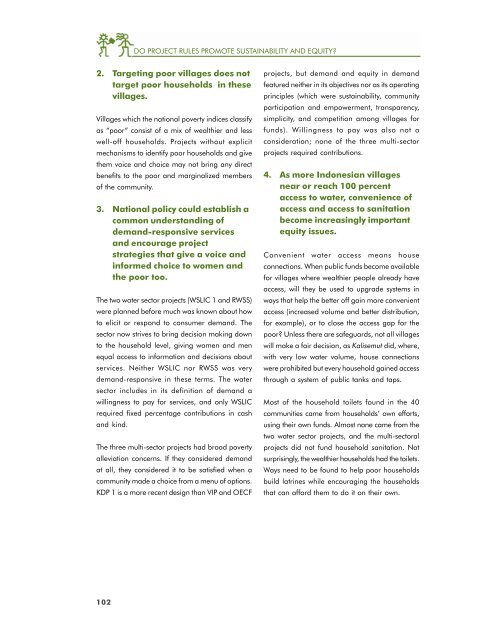Sustainability Planning and Monitoring
Sustainability Planning and Monitoring
Sustainability Planning and Monitoring
- No tags were found...
You also want an ePaper? Increase the reach of your titles
YUMPU automatically turns print PDFs into web optimized ePapers that Google loves.
DO PROJECT RULES PROMOTE SUSTAINABILITY AND EQUITY?2. Targeting poor villages does nottarget poor households in thesevillages.Villages which the national poverty indices classifyas “poor” consist of a mix of wealthier <strong>and</strong> lesswell-off households. Projects without explicitmechanisms to identify poor households <strong>and</strong> givethem voice <strong>and</strong> choice may not bring any directbenefits to the poor <strong>and</strong> marginalized membersof the community.3. National policy could establish acommon underst<strong>and</strong>ing ofdem<strong>and</strong>-responsive services<strong>and</strong> encourage projectstrategies that give a voice <strong>and</strong>informed choice to women <strong>and</strong>the poor too.The two water sector projects (WSLIC 1 <strong>and</strong> RWSS)were planned before much was known about howto elicit or respond to consumer dem<strong>and</strong>. Thesector now strives to bring decision making downto the household level, giving women <strong>and</strong> menequal access to information <strong>and</strong> decisions aboutservices. Neither WSLIC nor RWSS was verydem<strong>and</strong>-responsive in these terms. The watersector includes in its definition of dem<strong>and</strong> awillingness to pay for services, <strong>and</strong> only WSLICrequired fixed percentage contributions in cash<strong>and</strong> kind.The three multi-sector projects had broad povertyalleviation concerns. If they considered dem<strong>and</strong>at all, they considered it to be satisfied when acommunity made a choice from a menu of options.KDP 1 is a more recent design than VIP <strong>and</strong> OECFprojects, but dem<strong>and</strong> <strong>and</strong> equity in dem<strong>and</strong>featured neither in its objectives nor as its operatingprinciples (which were sustainability, communityparticipation <strong>and</strong> empowerment, transparency,simplicity, <strong>and</strong> competition among villages forfunds). Willingness to pay was also not aconsideration; none of the three multi-sectorprojects required contributions.4. As more Indonesian villagesnear or reach 100 percentaccess to water, convenience ofaccess <strong>and</strong> access to sanitationbecome increasingly importantequity issues.Convenient water access means houseconnections. When public funds become availablefor villages where wealthier people already haveaccess, will they be used to upgrade systems inways that help the better off gain more convenientaccess (increased volume <strong>and</strong> better distribution,for example), or to close the access gap for thepoor? Unless there are safeguards, not all villageswill make a fair decision, as Kalisemut did, where,with very low water volume, house connectionswere prohibited but every household gained accessthrough a system of public tanks <strong>and</strong> taps.Most of the household toilets found in the 40communities came from households’ own efforts,using their own funds. Almost none came from thetwo water sector projects, <strong>and</strong> the multi-sectoralprojects did not fund household sanitation. Notsurprisingly, the wealthier households had the toilets.Ways need to be found to help poor householdsbuild latrines while encouraging the householdsthat can afford them to do it on their own.102
















